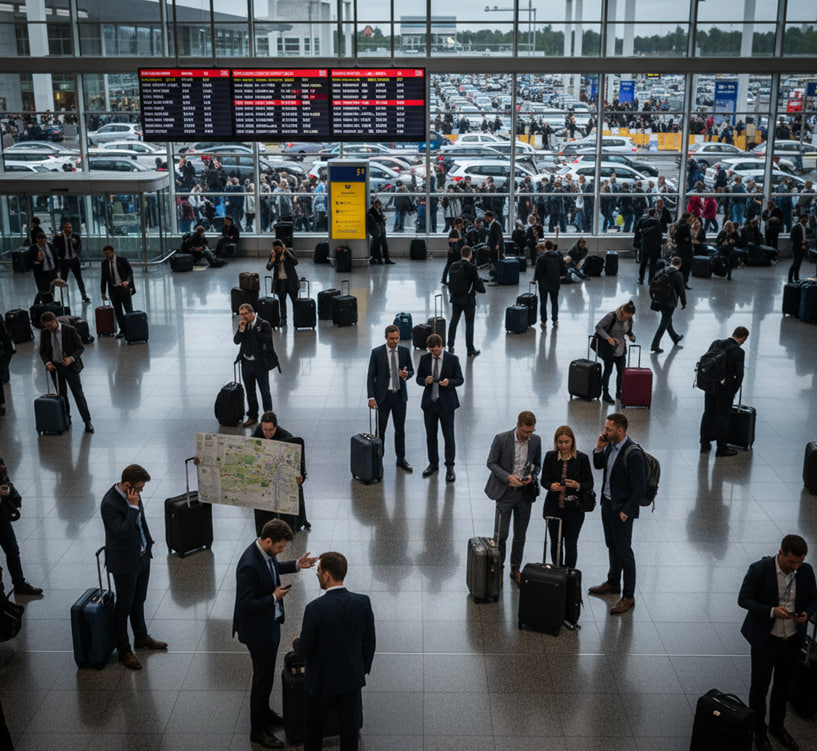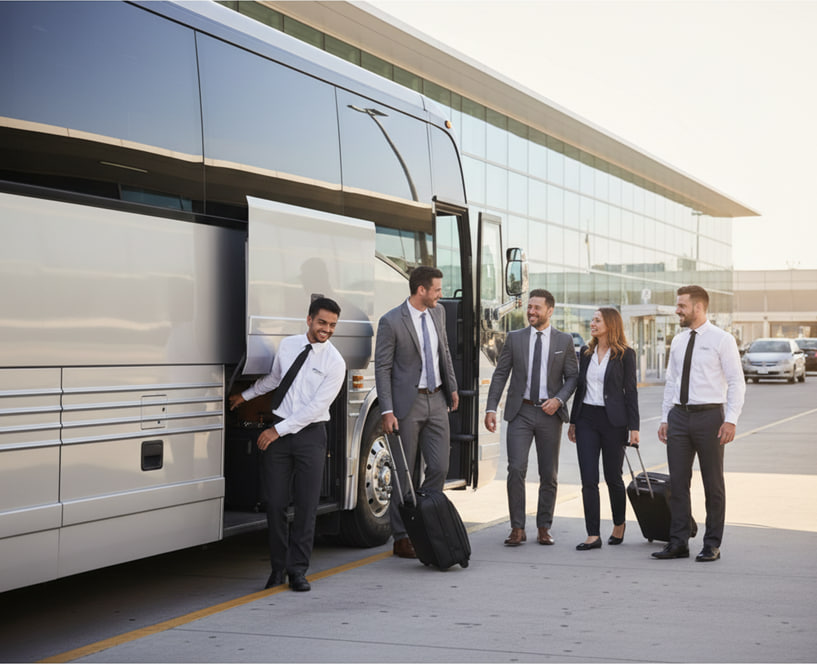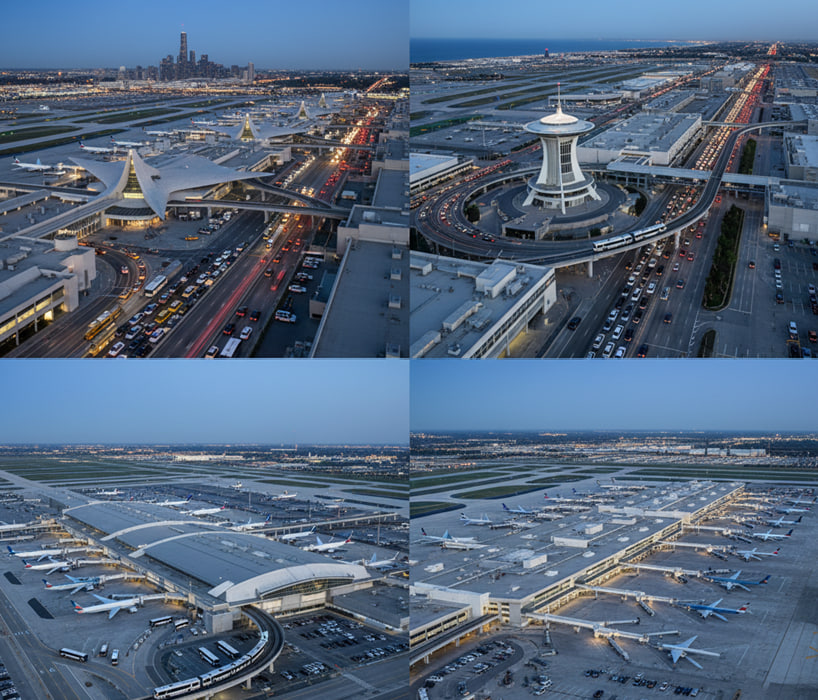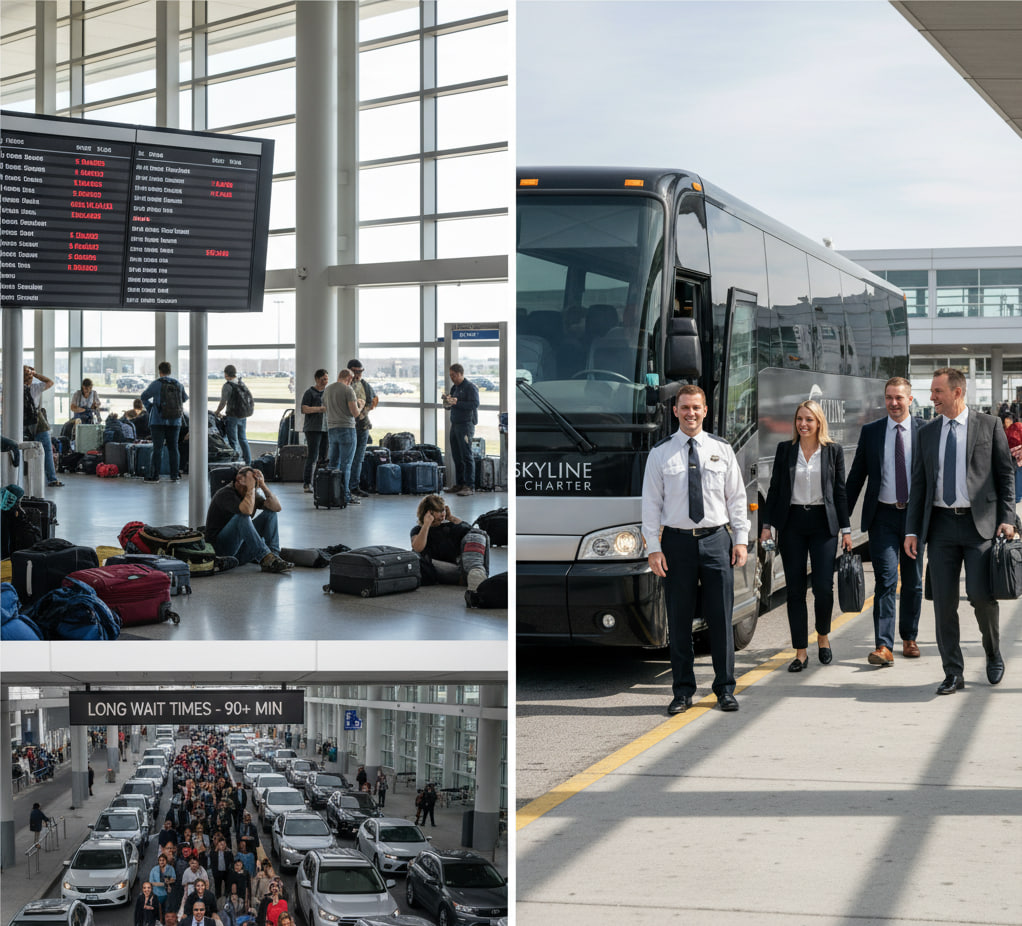Getting from the airport to your final destination should be the easiest part of your journey, but what happens when flight delays, cancellations, or group travel logistics turn this simple task into a major headache? Whether you’re traveling solo or managing a large group, understanding all your transportation options can save you time, money, and significant stress.
In this comprehensive guide, we’ll explore every transportation method available from major airports, with special focus on what to do when flights don’t go as planned and why charter buses are becoming the smart traveler’s secret weapon for group transfers.
Understanding Airport to City Transportation Options
Traditional Transportation Methods
Taxis and Rideshares The most common choice for individual travelers, taxis and rideshare services like Uber and Lyft offer door-to-door convenience. However, during peak hours or adverse weather conditions, surge pricing can increase costs by 200-400%. For groups of 5+ people, multiple vehicles are needed, making this option expensive and logistically challenging.
Public Transportation Most major airports offer rail, bus, or subway connections to city centers. While cost-effective for solo travelers, public transit becomes impractical for groups with luggage, especially during flight delays when services may be reduced or overwhelmed.
Rental Cars Ideal for travelers planning extended stays, rental cars provide maximum flexibility. However, airport rental locations often experience long wait times during disruptions, and navigating unfamiliar cities while managing jet lag presents safety concerns.
Airport Shuttles Shared shuttle services offer a middle ground between cost and convenience, but fixed schedules and multiple stops can add hours to your journey, particularly problematic when dealing with delayed arrivals.

When Flight Delays Change Everything
The Reality of Flight Disruptions
According to the Bureau of Transportation Statistics, approximately 20% of flights experience delays of 15 minutes or more, with weather-related cancellations affecting thousands of passengers daily. When your 2 PM arrival becomes an 8 PM arrival, your carefully planned transportation arrangements often fall apart.
Common Delay Scenarios That Affect Ground Transportation:
- Weather-related delays causing missed shuttle reservations
- Late arrivals exceeding public transportation operating hours
- Group members arriving on different delayed flights
- Hotel shuttles no longer operating at revised arrival times
- Increased demand causing surge pricing in rideshare services
The Group Travel Challenge
Managing transportation for business teams, wedding parties, conference attendees, or tour groups presents unique challenges that multiply during flight disruptions:
Coordination Complexity When 15-50 people need to reach the same destination, coordinating multiple taxis or rideshares becomes a logistical nightmare. Group members may be separated, arrive at different times, or face varying costs.
Communication Breakdown Flight delays scatter group members across departure gates, making real-time coordination difficult. Traditional transportation methods lack the flexibility to adapt to changing circumstances.
Budget Control Individual transportation choices can quickly exceed planned budgets, especially during surge pricing periods common after weather delays or major events.
Charter Buses: The Strategic Solution for Airport Transfers
Why Charter Buses Excel During Disruptions
Charter bus services have emerged as the preferred solution for airport transfers when traditional methods fail. Unlike fixed-schedule shuttles or surge-prone rideshares, professional charter services adapt to changing circumstances while maintaining cost predictability.
Flexibility and Reliability Professional charter companies monitor flight statuses in real-time, adjusting pickup times automatically. This means no missed connections, no surge pricing, and no scrambling for alternative transportation at midnight.
Group Coordination A single vehicle keeps your entire group together, maintaining communication and ensuring everyone arrives safely at the same destination simultaneously.
Professional Service Standards Licensed charter operators provide trained drivers familiar with airport protocols, optimal routes, and local traffic patterns. Many services, including BcsBusCharter, offer 24/7 support and specialized experience in handling complex group logistics during travel disruptions.
Cost Analysis: Charter vs. Individual Transportation
For groups of 10 or more, charter buses often cost less per person than individual transportation methods, especially during peak demand periods:
Example: 20-person group from JFK to Manhattan
- Taxis (surge pricing): $35-60 per person = $700-1,200 total
- Rideshare (peak hours): $40-70 per person = $800-1,400 total
- Charter bus: $25-35 per person = $500-700 total
The savings increase dramatically during weather delays or major events when surge pricing can double individual transportation costs.

Airport-Specific Transportation Strategies
Major Hub Considerations
JFK International Airport (New York) AirTrain connections to subway system work well for individuals but become challenging for groups with luggage. The Long Island Expressway and Van Wyck Expressway experience severe congestion during weather delays, making flexible charter services invaluable for time-sensitive group transfers.
Los Angeles International Airport (LAX) LAX’s ongoing construction projects create unpredictable traffic patterns. Charter buses with experienced local drivers navigate construction zones efficiently while rideshare pickup areas often experience significant delays during peak times.
O’Hare International Airport (Chicago) Chicago’s weather-related delay frequency makes backup transportation plans essential. The Blue Line provides city access but doesn’t serve many suburban destinations, making charter buses ideal for groups heading to conferences or events outside downtown Chicago.
Hartsfield-Jackson Atlanta International Airport (ATL) As the world’s busiest airport, ATL’s ground transportation becomes overwhelmed during widespread delays. MARTA train service stops at midnight, leaving late-arriving groups stranded without charter alternatives.
International Arrival Considerations
International flights face additional complications including customs delays, connecting flight missed connections, and jet lag affecting decision-making abilities. Charter services specializing in international arrivals understand these challenges and provide streamlined solutions.
Best Practices for Airport Transportation Planning
Pre-Trip Planning Strategies
Research Multiple Options Before traveling, identify 2-3 transportation methods suitable for your group size and budget. Save contact information for charter services specializing in airport transfers.
Build in Flexibility Book transportation services that offer flight monitoring and automatic adjustments. Confirm cancellation policies and rebooking procedures before departure.
Establish Communication Protocols For group travel, designate a single point person for transportation coordination. Share contact information and meeting procedures with all travelers.
During Disruption Management
Stay Informed Monitor weather forecasts and air traffic control updates through official airline apps rather than relying solely on gate announcements.
Maintain Group Communication Use group messaging apps to coordinate real-time updates and transportation changes across all travelers.
Have Backup Plans Keep contact information for multiple transportation providers readily available, including 24-hour charter services for emergency situations.
Technology Integration and Modern Solutions
Real-Time Coordination Tools
Modern charter services integrate flight tracking technology, allowing automatic schedule adjustments without passenger intervention. GPS tracking provides real-time location updates, while mobile apps streamline communication between passengers and drivers.
Mobile App Features
- Live flight status monitoring
- Automatic pickup time adjustments
- Driver location tracking
- Group messaging capabilities
- Digital receipt and expense reporting
Sustainable Transportation Options
Environmental consciousness increasingly influences transportation choices. Charter buses offer superior fuel efficiency per passenger compared to individual vehicles, reducing carbon footprints for group travel. Many operators now offer hybrid or electric vehicle options for eco-conscious travelers.
Emergency Preparedness and Contingency Planning
Weather-Related Contingencies
Severe weather events can shut down airports for hours or days, stranding thousands of passengers. Having relationships with ground transportation providers becomes crucial during these scenarios.
Storm Preparation Checklist
- Identify charter services with 24/7 availability
- Confirm backup routes and alternative destinations
- Establish group communication protocols
- Prepare emergency contact lists
- Research overnight accommodation options
Medical and Special Needs Considerations
Group travel often includes passengers with mobility challenges, medical equipment, or special dietary needs. Professional charter services accommodate these requirements better than ad-hoc transportation arrangements made during stressful delay situations.
Cost Optimization Strategies
Group Size Economics
Transportation costs per person decrease significantly as group size increases, making charter options increasingly attractive for larger groups:
Break-Even Analysis by Group Size
- 5-8 people: Individual methods often cheaper
- 9-15 people: Charter becomes competitive
- 16+ people: Charter provides clear cost advantage
Advance Booking Benefits
Most charter services offer substantial discounts for advance bookings, with additional savings for round-trip arrangements. Corporate accounts and frequent group travelers often receive preferential pricing and priority scheduling.

Industry Trends and Future Developments
Technology Integration
The transportation industry continues evolving with enhanced mobile applications, real-time tracking, and integrated booking systems. Future developments include AI-powered route optimization and predictive delay management.
Emerging Technologies
- Autonomous vehicle integration for airport shuttles
- Blockchain-based booking and payment systems
- Advanced weather prediction for proactive planning
- IoT integration for luggage tracking and management
Regulatory Changes
Recent changes in commercial vehicle regulations affect charter operations, generally improving safety standards and driver qualifications. The Federal Motor Carrier Safety Administration continues updating requirements for commercial passenger transportation, benefiting travelers through enhanced safety protocols.
Making the Smart Choice for Your Next Trip
Decision Framework
When planning airport transportation, consider these key factors:
- Group size and luggage requirements
- Destination accessibility via public transportation
- Time constraints and schedule flexibility needs
- Budget parameters and cost predictability requirements
- Weather forecast and potential delay risks
Professional Service Selection
Choose transportation providers with:
- Proper licensing and insurance coverage
- 24/7 customer support capabilities
- Flight monitoring and automatic adjustment services
- Positive customer reviews and industry reputation
- Experience handling airport transfers and group logistics
For comprehensive information about aviation industry regulations and safety standards, consult the Federal Aviation Administration guidelines.
Conclusion: Preparing for the Unexpected
Smart travelers prepare for transportation disruptions before they occur. While individual transportation methods work well under ideal conditions, group travel and flight delays require more robust solutions.
Charter bus services provide the flexibility, reliability, and cost-effectiveness needed when airline schedules go awry. By understanding all your options and preparing backup plans, you can navigate airport transportation challenges with confidence, ensuring your journey continues smoothly regardless of what the skies throw your way.
Remember: the goal isn’t just reaching your destination – it’s arriving together, on budget, and ready for whatever comes next in your travels.

